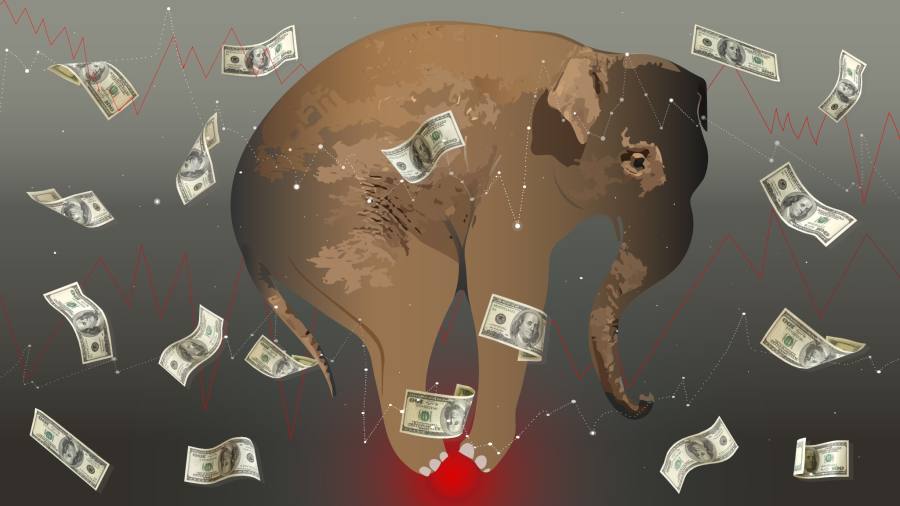[ad_1]
This month, a “whodunnit†— or “what-did-it†— mystery hangs over markets. No, this is not about gyrations in bitcoin prices or GameStop shares.
Instead, the issue is the $21tn US Treasuries sector. In March 2020, as Covid-19 hit the west, Treasury prices went haywire as market liquidity collapsed. That was shocking in a sector that is normally “the largest and most liquid government securities market in the worldâ€, according to the Federal Reserve.
Fed officials eventually unblocked the market with unprecedented interventions, gobbling up Treasuries itself. After peace returned, some investors — and politicians — seemed minded to sweep that horror under the rug. But, a year on, we need to solve the mystery of what happened for three reasons. First, the system came close to disaster. Or, as Randal Quarles, a Fed governor, has observed: “For a while in the spring [of 2020] the outcome was — as the Duke of Wellington said of Waterloo — ‘a damn close-run thing’.â€Â
Second, the bond market will face new stresses if (or when) US monetary policy tightens. Last week, the markets started to gyrate alarmingly again as inflation concerns emerged.
Third, the source of the March turmoil is not widely understood. This is unnerving if you want to devise policy to avoid a repeat. Initially, Fed sleuthing suggested hedge funds were responsible. Soon after the event, Fed officials reported that “leveraged investors that bought Treasuries in the cash market and hedged the interest rate risk with futures contracts started unwinding these positions as futures prices rose, leading to a feedback loopâ€.
That invoked memories of the 1998 debacle around Long-Term Capital Management fund, and prompted the Financial Stability Board to call for action to “address vulnerabilities from non-bank financial intermediation†— that is, more oversight and controls. That appeal makes sense in a general way. The NBFI sector has exploded since 2008, and remains alarmingly opaque. Few observers even knew that hedge funds were so exposed to Treasuries before March 2020.
But subsequent Fed investigation also suggests it is a mistake to blame hedgies alone. One reason is that foreign institutions also dumped Treasuries in a destabilising way. Second, the behaviour of some of Wall Street’s big banks was odd. In years past, they happily acted as market makers in the Treasuries sector, since they hold vast quantities of such bonds. More specifically, brokers play a crucial role in the repurchase (repo) markets where investors raise finance by swapping bonds for cash, thus lubricating the wheels of finance.
But late last year a report by the New York Fed noted that during the March 2020 turmoil “relative to normal times, dealers did not make their securities as available to other market participantsâ€, even though their stocks of Treasuries had surged. In plain English, this means brokers secretly went on strike. The turmoil was not just a demand problem — that nobody would buy Treasuries — but a supply issue, because brokers had stopped cutting deals, even for repo.
This is alarming, since it points to bigger structural issues. Quarles thinks the March debacle shows that the $21tn Treasuries market “may have outpaced the ability of the private-market infrastructure to support stress of any sortâ€. This is partly because US debt keeps expanding. But it is also because post-2008 reforms have raised the capital buffers banks need to do market-making activity, causing them to shy away. Either way, the situation is like an ever-swelling elephant balancing on a shrinking ball: if the ground is still, the situation might seem stable; but, if not, it is easy to tumble.Â
Can this be fixed? Not easily. The Biden administration is unlikely to implement any rollback of post-2008 reforms. It is even more unlikely to cut the debt. But a recent paper from the Brookings Institution outlines some policy options, such as better monitoring of NBFI and regulatory tweaks making it easier for brokers to be market makers.
More controversially, the paper also calls for “serious consideration of a mandate for wider use of central clearing for Treasury securities†and “a new Federal Reserve standing repo facility that would serve as a backstop for the US financial system by providing funding to regulated dealers based on US Treasury and agency collateralâ€.
Might this fly? The last idea is already being implemented on a supposedly temporary basis, since the Fed only curbed the March 2020 dramas by introducing “emergency†measures to backstop repo markets. This is a striking extension of the central bank’s role, but it has sparked little protest, probably because few outsiders understand repo.
But relying on ad hoc emergency measures is not a good way to make policy, not least because it creates moral hazard. So, as the March anniversary looms, the Fed should explain to the public in easy-to-understand language what created the problem, and how to avoid a repeat.
In that respect, it would make sense to create a standing repo facility. There are big drawbacks to extending the Fed’s mandate (even) further: no one wants the system to become even more dependent on central banks. But we cannot afford to have the Treasuries market overwhelmed again, least of all as inflation concerns mount.
[ad_2]
Source link





